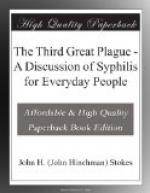+Control of Infectiousness by Treatment—Importance of Salvarsan.+—In a disease which yields so exceptionally well to treatment as syphilis, a great deal can be done to shorten the contagious period. Especially is this so when we are able to employ an agent such as salvarsan, which kills off the germs on the surface within twenty-four hours after its injection. When a patient is discovered to be in a contagious state, in a large majority of cases the risk to the community which he represents can be quickly eliminated, at least for the time being. Combining the use of mercury and salvarsan in accordance with the best modern standards, the actively contagious period as a whole can be reduced in average cases from a matter of years to one of a few weeks or months. Certainly, so far as recognizable dangerous sores are concerned, periodic examination, with salvarsan whenever necessary, would seem to dispose of much of the difficulty.
+Obstacles to Control by Treatment.+—There are, however, obstacles in the way of complete control of infectiousness by treatment. For example, one might ask whether a single negative blood test would not be sufficient assurance that the patient was free from contagious sores. It is, however, a well-recognized fact that a person with syphilis may develop infectious sores about the mouth and the genitals even while the blood test is negative. An examination, moreover, is not invariably sufficient to determine if a patient is in a contagious state. The value of an examination depends, of course, entirely on its thoroughness and on the experience of the physician who makes it. It is only too easy to overlook one of the faint grayish patches in the mouth or a trifling pimple on the genitals. The time and special apparatus for a microscopic examination are not always available. Moreover, contagious lesions come and go. One may appear on the genitals one day and a few days later be gone, without the patient’s ever realizing that it was there—yet in this interval a married man might infect his wife by




